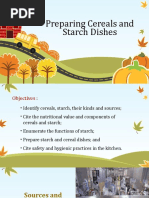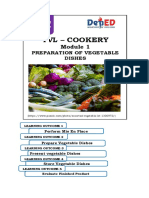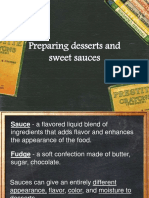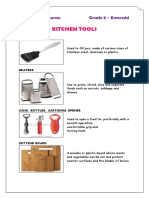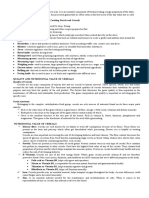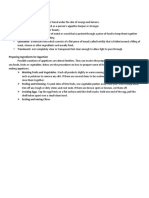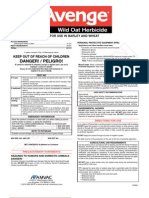CEREALS
Uploaded by
Glenda JacaCEREALS
Uploaded by
Glenda JacaCEREALS
Starch is the most important plant products to man. It is an essential component of food providing a large proportion of the daily
calorie intake. Cereals are food made from the processed grains that are often eaten as the first meal of the day either hot or cold.
Common Tools and Equipment Used in Cooking Starch and Cereals
Deep fryer- cooking equipment used for deep- frying.
Frying pan- used for frying, sautéing and other recipes prepared in fats.
Steamer- used for cooking food by steaming
Double boiler- used for preparing sauces which easily get scorched when cooked directly on the stove.
Baine marie- used for cooking delicate food such as custards and terrines to create a gentle and uniform heat around the
food.
Mandoline- a slicer that produces uniform thickness. Used in making waffle cuts, crinkle cuts, and dicer.
Blender- a kitchen appliance used to mix, puree or emulsify food and other substances.
Oven- a kitchen appliance used for heating and baking.
Bread knife- used for slicing bread
Mixing bowl- used when preparing ingredients, cake mixtures, salads, creams and sauces.
Measuring spoons- used for measuring small amount of ingredients.
Measuring cups- used for measuring dry ingredients, such as sugar and flour.
Weighing scale- used to measure large quantities of ingredients, such as rice, sugar, meat and fish.
Electric mixer- used in different baking procedures to beat, stir and blend ingredients.
Rolling pin- this tool is used to roll or flatten paste or dough.
Paring knife- this is used to pare or cut fruits and vegetables into different sizes.
QUALITY AND NUTRITIONAL VALUE OF CEREALS
Quality of Cereals
Cereals are the main component of human diet and are crucial to human survival. Three species, wheat, rice and maize
account for the bulk of human food. The functional and nutritional qualities of cereals determine their suitability for specific
purpose and may limit the quality of the end product. The factors that determine the grain quality is thus important in the
maintenance of efficient and sustainable food production. The grain composition and quality is important in selecting grain for
specific uses.
Grain Anatomy
Belonging to the complex carbohydrates food group, cereals are rich sources of nutrients found on its three major parts
namely:
Bran is the outer layer of the grain which is a good source of fiber, omega- 3 fatty acids, vitamins and dietary minerals.
Endosperm is the main or the large part of the grain which consist mainly of starch.
Germ is the smallest structure at the rare part of the kernel. Rich in vitamin E, folate, thiamine, phosphorous and
magnesium. This germ is the storehouse of nutrients for the seed while germinating.
NUTRITIONAL VALUE OF CEREALS
Dietary fiber. Cereals are best known for its ability to ward off constipation because of its fibers. These fibers are
present in the bran and pericarp which often get demolished while processing. Brown rice is helpful in treating
constipation.
Cereals are also important in lowering the risk of developing diabetes and heart disease. The fiber content decreases the
speed of glucose secretion from food thereby maintaining sugar levels in blood. Many studies have shown that colon
cancer can be avoided by consuming any fiber- rich cereals.
Protein. These are present in every tissue of cereal grains. Protein content varies in each type of cereals. Rice contains
less protein in comparison to other cereals. Oats have the highest food value of any of the cereals. They contain food
proportion of protein and fat which helps maintain the immune system. Protein in cereals benefits heart health and may
reduce the risk of developing diabetes.
B Vitamins. Cereals are one of the best energy foods. Whole grain cereals provide vitamin B and are therefore
protective foods. Folic acid, niacin, thiamine, and riboflavin are all B vitamins that serve different purposes in the body.
Folic acid or Vitamin B9, helps cells grow and reproduce
Niacin or Vitamin B3, is responsible for nervous system functions and gastrointestinal health
Thiamine or Vitamin B1, helps maintain appetite and growth
Riboflavin or Vitamin B2, helps cell function normally
Iron. Cereals provide iron, an essential mineral, helps transport oxygen throughout the body. An iron deficiency could
cause fatigue and a decreased immunity.
Zinc. Is an essential nutrient needed for the maintenance and metabolization of cells. When it comes to the
representation of zinc in cereals, this nutrient is all over the board.
SOURCES AND KINDS OF STARCH OF STARCH AND CEREALS
Wheat. Most common cereal produced in the western and is grown in most temperate regions. Large quantities are home
grown and a great deal particularly in the form of strong flour.
Production of Flour
The endosperm of the wheat grain contains all the material used by the baker. It consists of numerous large cells in
which starch grains are tightly packed. The cells contain an insoluble protein called gluten. When flour is mixed with water it
is converted into sticky when moistened. The relative proportion of starch and gluten varies in different wheat and those with
a low percentage of gluten are not suitable for bread making (soft flour). For this, reason, wheat is blended.
In milling, the whole grain is broken up, the parts separated, sifted, blended and ground into flour. Some of the outer
coating of bran is removed as is also the wheat germ which contains oil and is likely to become rancid and spoils the flour.
For this reason whole meal flour should not be stored for more than 14 days.
Kinds of Flour
1. White Flour. Contains 70- 72% of the whole grain (the endosperm only). Examples are, all-purpose flour and enriched
flour (a white flour with nutrients added on it).
2. Wholemeal flour. Contains 100% of whole grain. This is commonly used for wholemeal bread and rolls.
3. Wheat meal flour. Contains 90% of the whole grain.
4. Self- rising flour. White flour with the addition of cream of tartar and bicarbonate of soda.
5. Semolina. Granulated hard flour prepared from the central part of the wheat grain.
6. Durum flour. Yields glutinous flour used especially in pasta. Durum flour is a by-product of semolina.
7. Soft flour. Used for cakes, biscuits, all pastry except puff and flaky, thickening soups and sauces, batters and coating
various food.
8. Strong flour. Used for bread, puff and flaky pastry and Italian pastas.
Oats are one of the hardest cereals. They are either rolled into flakes or ground into three grades of oatmeal: coarse, medium
and fine. Oats are used in rolled oats- porridge, oatmeal- porridge, thickening soups, coating food, cakes and biscuits.
Barley is made of pearl barley when the grains are husked, steamed, rounded and polished. Pearl barley is also ground into
fine flour. These products are used for making barley water for thickening soups and certain stews. When roasted, barley is
changed into malt and as such is used extensively in the brewing and distilling of vinegar.
Maize is also known as corn, sweet corn or corn- on- the cob and besides being served as a vegetable, it is processed into
cornflakes and corn flour.
Corn flour is the crushed endosperm of the grain which has the fat and protein washed out so that it is practically pure
starch. This is used for making custard and blancmange powder, because it thickens easily with liquid and sets when cold into
a smooth paste that cannot be made from other starches. Corn flour is also used for thickening soups, sauces, custards.
Rice cereal grass is widely cultivated in warm climate for its seeds and by products. Rice depends on the variety, the length
of storage, grain size, shape and color, cleanliness or if it is free from dirt or foreign substances. There are two types of rice
grain:
1. Long grain- a narrow-pointed grain, best for savoury dishes and plain boiled rice because of its firm structure which
helps to keep the rice grains separate.
2. Short grain- a short, rounded grain, best suited for milk puddings and sweet dishes because of its soft texture.
Kinds of Rice
1. Brown rice is any rice that has the outer covering removed but retains its bran and as a result is more nutritious.
2. Wild rice is the seed of an aquatic plant related to the rice family.
3. Ground rice is used for milk puddings
4. Rice paper is a thin edible paper produced from rice and is used in making macaroons and nougat.
Tapioca is obtained from the roots of tropical plant called cassava. It is used for garnishing soups, milk puddings, and other
native delicacies.
Sago is produced from the pith of the sago palm. It is used for garnishing, soups, and other native desserts.
Methods of Cooking Starch and Cereal Dishes
1. Cooking Cereals by Boiling, this requires constant watching and stirring to keep from sticking, and large quantity of
water is added thus a certain amount of starch and soluble material is lost.
2. Cooking Cereals in the Double Boiler, the most satisfactory way of cooking cereals, the long cooking that is necessary to
prepare them at a low temperature develops a delicious flavor which cannot be achieved by rapid cooking at the boiling
point.
3. Cooking Cereals in the Fireless Cooker, it is advisable to use this device when cooking for it saves fuel and effort.
4. Cooking Cereals by Dry Heat, browning and toasting is the old method of cooking cereals and it involves dry heat. By
this method, the flavor of cereals is developed and their digestibility is increased.
Things to Observe in Cooking Cereals
In cooking cereals, it is always necessary to use liquid of some kind except in browning or toasting. The quantity of
liquid however varies with the kind of cereal to be cooked. Whole cereals and those coarsely- ground require more liquid
than those which are finely crushed or finely ground. The liquid to be used should be in proportion to the grain.
The length of time to cook cereals also varies with their kind and form. The coarse ones requires more time than the
fine ones.
PRESENTING STARCH AND CEREAL DISHES
Following are factors to consider in presenting starch and cereal dishes.
1. Practicality
Make sure serving sizes of cereal dishes are correct.
Do not allow large items to hide any part of the presentation
Ensure that the garnish and slice correlate
Proper arrangement of slices towards the customer
2. Balance
The repetition should be avoided. The balance involves the following aspects.
Selection of food (simple vs. complex)
Color- the use of earth tones with vibrant color is often successful and it is easier to match food and colors. Two
or three colors on plate are usually more interesting than one.
Cooking techniques- a variety of techniques will automatically add a variety of textures to the presentation.
Shapes. Avoid combining same shapes in one plate
Portion size
3. Unity
Strict attention must be paid to the compatibility of the food items on the plate.
4. Texture
This is important in plating as in menu planning
5. Flavors
You cannot see flavor but is one more factor you must consider when balancing colors, shapes and textures on the
plate
6. Temperature
Serve hot cereal dishes hot on hot plates
Serve cold starch and cereal dishes on cold plates
Garnishing
Follow are some garnishing tips you can follow:
Garnishes should always be edible
Fresh herbs are fantastic and very easy way to add instant visual interest, color, fragrance and flavor.
Use fresh seasonal fruit sauces in a squirted bottle with a zigzag across the bottom to dress up desserts.
The components of a cereal dish can be a garnish itself
Use only relevant or complementary ingredients or flavors.
TECHNIQUES FOR STORING STARCH AND CEREAL DISHES
To maintain the optimum freshness and quality of starch and cereals, follow the given technique:
Wheat should be stored in a dry and well- ventilated store room
Flour should be removed from the sacks and wheeled bins with lid
Flour bins should be of type that can easily be cleaned
Because of fat content, the keeping quality of oat products needs extra care. They should be kept in containers
with tight fitting lids and stored in a cool, well- ventilated store room
Tapioca and sago should be stored as for rice
Arrowroot is easily contaminated by strong smelling foods therefore it might be stored in air-tight tins.
You might also like
- Food Sources and Kinds of Starch and Cereals86% (7)Food Sources and Kinds of Starch and Cereals4 pages
- LESSON 1: Determining The Primal and Sub-Primal Cuts of Meat100% (1)LESSON 1: Determining The Primal and Sub-Primal Cuts of Meat16 pages
- 10 COOKERY Q2M6tle10 He Cookery q2 Mod5 Evaluatingthefinishedproduct v3 (50 Pages)100% (2)10 COOKERY Q2M6tle10 He Cookery q2 Mod5 Evaluatingthefinishedproduct v3 (50 Pages)54 pages
- The Candida Diet With Food Lists & Food Notes100% (2)The Candida Diet With Food Lists & Food Notes18 pages
- Ppt... Preparation of Cereals Starch Dishes67% (3)Ppt... Preparation of Cereals Starch Dishes48 pages
- Leson 2: Prepare Cereals and Starch DishesNo ratings yetLeson 2: Prepare Cereals and Starch Dishes70 pages
- Nutritional Value and Components of Cereals and StarchNo ratings yetNutritional Value and Components of Cereals and Starch6 pages
- Factors To Consider in Choosing Good Quality Vegetables100% (1)Factors To Consider in Choosing Good Quality Vegetables21 pages
- Common Tools and Equipment Used in Cooking Starch and Cereals100% (1)Common Tools and Equipment Used in Cooking Starch and Cereals23 pages
- Lesson 3 - Types of Seafoods: Report By: Lex Cabrera & Jeremy FelicianoNo ratings yetLesson 3 - Types of Seafoods: Report By: Lex Cabrera & Jeremy Feliciano30 pages
- Grade 10 Cookery: Prepare Cereals and StarchNo ratings yetGrade 10 Cookery: Prepare Cereals and Starch31 pages
- I. MULTIPLE CHOICE: Encircle The Letter of The Correct Answer. (1 Point Each)100% (1)I. MULTIPLE CHOICE: Encircle The Letter of The Correct Answer. (1 Point Each)4 pages
- The Difference Between Soups, Sauces, and Stocks100% (1)The Difference Between Soups, Sauces, and Stocks5 pages
- Quarter Iv Lesson 1 Preparation of Dessert100% (1)Quarter Iv Lesson 1 Preparation of Dessert19 pages
- Factors For Consideration in Presenting Egg Dishes100% (4)Factors For Consideration in Presenting Egg Dishes7 pages
- Prepare Cereal and Starch Dishes Weeks 7-8: Quarter 1 - Module 4No ratings yetPrepare Cereal and Starch Dishes Weeks 7-8: Quarter 1 - Module 416 pages
- TLE - Cookery: Quarter 1 Lesson 2: Prepare Cereals and Starch100% (4)TLE - Cookery: Quarter 1 Lesson 2: Prepare Cereals and Starch10 pages
- TLEBPP10 - Q2 - Mod3 - Types and Classification of Pastry Products and Different Types of Pastry Fillings - V4100% (1)TLEBPP10 - Q2 - Mod3 - Types and Classification of Pastry Products and Different Types of Pastry Fillings - V419 pages
- Functions of Starch and Application in Filipino Dishes100% (1)Functions of Starch and Application in Filipino Dishes35 pages
- General Guidelies and Principles in BakingNo ratings yetGeneral Guidelies and Principles in Baking22 pages
- Physical Structure and Composition of Eggs100% (2)Physical Structure and Composition of Eggs20 pages
- LO2-Prepare and Cook Starch and Cereal Dishes100% (6)LO2-Prepare and Cook Starch and Cereal Dishes15 pages
- Prepare Cereals and Starch Dishes: Perform Mise'en Place: Cookery100% (3)Prepare Cereals and Starch Dishes: Perform Mise'en Place: Cookery15 pages
- Brochure - Whole Grains and Oats in The Asian DietNo ratings yetBrochure - Whole Grains and Oats in The Asian Diet11 pages
- Morphological Characteristics of Different Fodder BerseemNo ratings yetMorphological Characteristics of Different Fodder Berseem5 pages
- Instant Download Journey Through the Philippines: An Unforgettable Journey from Manila to Mindanao 1st Edition Kiki Deere PDF All Chapters100% (3)Instant Download Journey Through the Philippines: An Unforgettable Journey from Manila to Mindanao 1st Edition Kiki Deere PDF All Chapters35 pages
- Wellness Made Easy 365 Tips For Better HealthNo ratings yetWellness Made Easy 365 Tips For Better Health47 pages
- Incubation: 622988 - Misotempeh - Finalpages - Indd 192 3/8/19 11:25 AmNo ratings yetIncubation: 622988 - Misotempeh - Finalpages - Indd 192 3/8/19 11:25 Am50 pages
- J Pediatr Gastroenterol Nutr - 2024 - Luque - Gluten Free Diet For Pediatric Patients With Coeliac Disease A PositionNo ratings yetJ Pediatr Gastroenterol Nutr - 2024 - Luque - Gluten Free Diet For Pediatric Patients With Coeliac Disease A Position23 pages
- Food Chemistry: M.L. Sudha, R. Vetrimani, K. LeelavathiNo ratings yetFood Chemistry: M.L. Sudha, R. Vetrimani, K. Leelavathi6 pages
- Trade of Canada, 1930: Condinsii) Preliminary ReportNo ratings yetTrade of Canada, 1930: Condinsii) Preliminary Report133 pages
- Computerized Livestock Management Information SystemNo ratings yetComputerized Livestock Management Information System46 pages
- A Two-Phase Solid-State Fermentation Process For Mushroom (Agaricus Bisporus) Production On Cereal GrainsNo ratings yetA Two-Phase Solid-State Fermentation Process For Mushroom (Agaricus Bisporus) Production On Cereal Grains11 pages
- Understanding Medical Surgical Nursing 2024 Scribd DownloadNo ratings yetUnderstanding Medical Surgical Nursing 2024 Scribd Download34 pages



